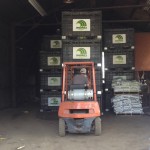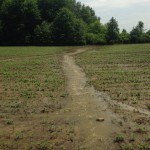This week was another great one at the Long Island Horticultural Research and Extension Center. I continued tackling my standard weekly tasks, visiting farms and scouting their fields for pests, working on field trials on-site, and setting up interviews with local growers about their interest and willingness to grow broccoli. I found that last task was particularly difficult because of the amazing weather we were having. It seems that on rainy days growers are much more eager to chat. The interviewing component of the week was therefore minimal. The highlight of the week for me was being able to scout potato fields located in the Hamptons. These fields were almost directly on the ocean and surrounded by unimaginably large houses. Scouting here provided the opportunity to see agrarianism and lavishness side by side: two things that are not normally found together. It was a great week and I’m certain next will be as well.
Wading Through a Sea of Chickens
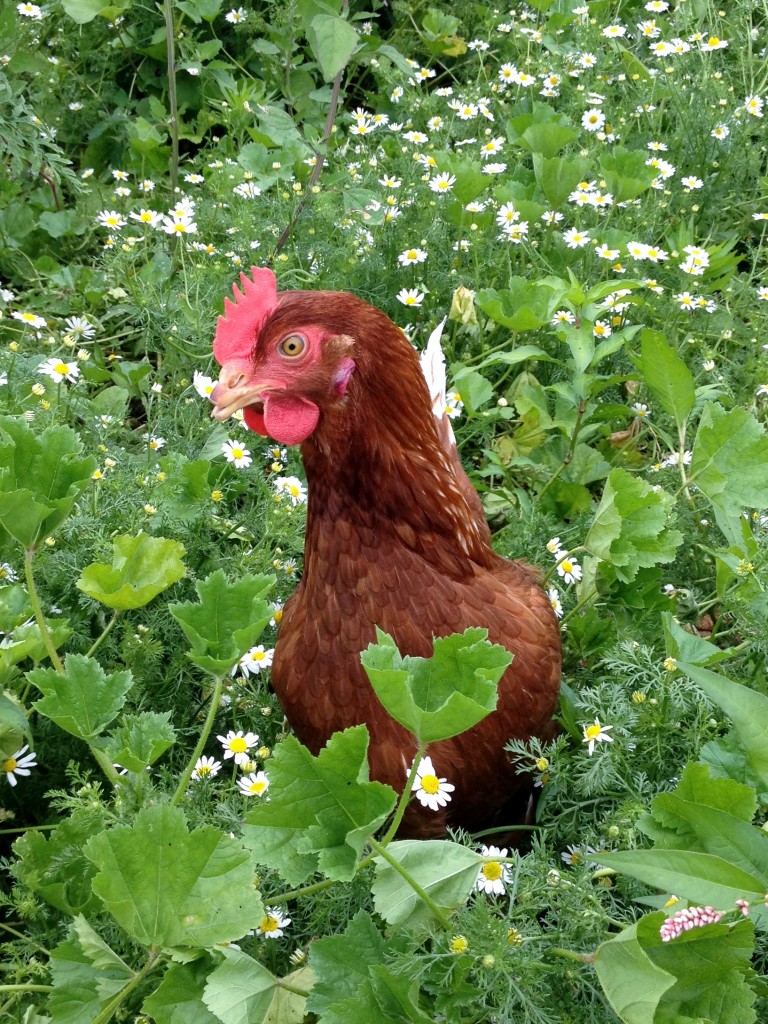
Happy hen on pasture
My first major job at Quails-R-Us was to set up electronet fencing for the laying hens. The nearly twelve hundred Red Sexlink hens had been inside for the first part of the year and were ready to begin the ‘free range’ part of their life. QRS doesn’t rotate their chickens on pasture, but instead has large semi-permanent runs accessed through chicken-sized doors in the barn wall. The food, water, and nest boxes are inside, but the bugs, grass, and sunshine are outside, and most of the hens spent at least part of their day taking dust baths and stretching their wings. Some of the hens had never been outside before, and required a lot of coaxing to become comfortable with the idea.
Every morning for my first two weeks I had the responsibility of caring for the layers. The process of feeding them and collecting eggs took me about two hours, but for the farmhand Ramone or the owners, it might take one and a half. I had never spent any significant time around chickens before and while I wasn’t necessarily afraid of them I was a little overly cautious. The layers I cared for this summer are very curious about human activity, and will readily crowd around your feet and refuse to move out of the way when you’re trying to walk through them. They constantly peck at any shiny object on your boots or hat or wrist. At first I was afraid of their beaks, but I quickly learned that being pecked by an overly broody hen isn’t that painful. As time went on I became more comfortable shooing them out of my way and being the dominant creature in the coop.
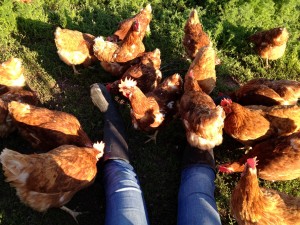
Hens swarming over me and my irresistible boots.
The chicken feeders, which are used for the meat birds as well as the layers, are basically hoppers you fill at the top, and as the chickens eat, more food falls down into the tray. Their water comes from permanent piping with a movable nozzle, and they can drink by using their tongue to push the nozzle up so water drips down, similar to a hamster waterer. Hoppers full of oyster shells were provided but rarely needed human attention. Feeding the chickens took a while because buckets of grain are very heavy, and I often had to make eight or more trips between feeders and the grain wagon. But egg collecting took longer.
The QRS layers have developed the unfortunate habit of refusing to lay in their nest boxes. Partially it’s because there are not enough nest boxes for the number of chickens. Usually you want one nest box for every five chickens; we needed about 250 nest boxes and were short by about 80. Additionally, many of the nest boxes had no backs, making them too bright and too open for the comfort of the chickens. Many laid their eggs instead on the floor in the darkest room of the coop, which had no nest boxes installed. Every day was an Easter egg hunt for me, as I got on my hands and knees to peer into dark corners and under feeders looking for eggs partially buried in the wood shaving floors. We tried many different strategies to get the layers to use their nest boxes. Some eggs collected from the floor were placed in nest boxes to get the hens to associate the boxes with egg laying. We put extra hay bedding in some boxes, both to make the boxes seem more inviting and to keep the eggs that were being laid inside cleaner. We put large rocks and boxes in the really problematic corners to deter laying. We put in pigeon nest boxes, which are shorter and shallower. We put some nest boxes flush with the floor. And we tried to remove eggs from the floor as soon as they were laid to disassociate the floor with egg laying. Our attempts were moderately successful…more eggs were being laid in the boxes when I left than there were when I arrived.
The collected eggs – about 85 dozen a day – were washed and packaged soon thereafter. After removing poop, dirt, hay pieces, and other non-delicious items in warm water, the eggs are air-dried then packaged in cartons stamped with the date of lay and stickered with the farm’s information. From my counts, about 7% of the eggs collected broke before packaging, either due to shell abnormalities, jostling of the buckets during collecting and transport, or simple human error. Broken eggs are fed to the pigs. QRS sells their eggs nest run, meaning they do not weigh them for size or grade them for quality. I still learned a lot about commercial egg selling, though. Sizes of eggs are based on weight of the entire carton together, rather than each individual egg. Every day we’d have one or two very small eggs and six or seven jumbo eggs, which often contained two yolks. The rest were large or extra-large. The variation in egg shell color, texture, thickness, and pattern was astonishing. Grading in eggs is done by candling – holding a light behind the egg to get a shadow view of the contents. While our eggs were never graded, our customers always come back raving about how good their breakfasts were, so I have to assume they are at least grade A. One thing is for sure: my farm fresh omelets were always delicious.
Grower Visits: Building Relationships 101
Throughout the summer, one of my tasks I described in the introduction post was meeting with growers throughout the sales district held by my DSM (District Sales Manager). Being in sales, the need for connection is the basis of a successful sale. In order to make the sale, you need to create a relationship with your customer to build trust and reliability, as well as a sense of loyalty to gain a returning client base. While all of these aspects are essential, no two of my visits have been the same. Each looks for different ways to make those connections, each customer looks for a different kind of advice, and a different level of attention to their product portfolio and operation. For the purpose of this post, I’d like to walk you through a typical day of making a couple farm visits to some well-established customers.
Usually, all of my days begin by meeting up with my DSM in order to go over the plan for the day. Some days I’m scouting, some days I’m making seed deliveries (which is wrapping up now that planting is just about over), and today, we will be making a few calls on growers. I follow him in my truck for the hour trip west into Pennsylvania, multi-tasking by joining on one of the intern class bi-weekly conference call sessions held by our team lead to check up on our progress. As we arrive to the farm, the grower is out in his shop working on some equipment. My DSM and I enter the building, saying hello and asking how his family is. Knowing his personality, this family is very family-oriented and this is a great way to open up conversation for the rest of the morning. From there, we start to discuss what we saw in the fields on our last visit, especially now that heavy rains have really affected the crop. After about an hour casual evaluation and commentary, the three of us jump into the truck to begin a bit of a farm tour.
Getting to the first field, we see that the incredible amount of rain have washed gullies into the ground and washed away some spots, which is not uncommon for the hilly ground. The growers notices that with his recent planting, the beans were very young and some of them “washed,” or were removed from the location where they were planted, leaving “skips” in the row. He made a comment to my DSM that he might just cultivate the beans back into the soil with a field cultivator and replant. Before telling him to go ahead with the decision and enacting the seed replant policy the Channel company offers, my DSM offers to give the field a brief look-over. After I grabbed the trusty field from the truck, we walked throughout the field and counted the number of missing plants in comparison to the 1/10 of an acre measurement in comparison to the intended planting population. We repeated this a few times, then came to the conclusion that it would not be necessary to replant, as the loss was not too great and the existing bean plants would compensate for the amount of space.
While this was the recommendation given by my DSM and I, we are still here to listen to the customer. Our grower decided that he would not replant, but if so, we would be ready to deliver him new seed when ready. The goal is to maintain the customer, and maintain the sale, hence through meeting the grower’s needs. Getting back into the truck, we visited a few more fields to do some “stand counts” (seeing how many plants emerged as a measure of weather conditions and seed quality) to check on the success of planting post-weather.
As any customer visits goes, it wouldn’t be complete unless we took the grower for lunch. While this may seem over-the-top to some, it not only shows a friendly gesture to the farmer indicating that we are glad to have their business, it also provides another good opportunity to sit down in a casual setting to discuss their ideas and perceptions of the products and what they would like to see. This is very important, as it gives my DSM and I an idea of how to better manage their account and to understand how we can incorporate ourselves into their production goals. Wrapping up lunch, we thanked him for his time and the chance to walk some fields with him as a grower’s time is very valuable. Next, it was time to drive to our second visit.
The second grower doesn’t have as long of a relationship or one that is as well-built as the grower we just visited, as the first one has been doing business with my DSM for years. This farmer is older, yet new to the company after a disagreement with the salesman of his old brand. This means that this customer and account has to be dealt with more carefully (not to say that we do not deal with accounts with equal care, this one just must be treated with a greater sense of professionalism rather than a sense of friendship). I have not met this farmer before, and as soon as I arrive I pleasantly introduce myself as an intern of the company in order to clear any questions about my presence on his operation. My DSM and I do similar activities as the first, asking questions about the status of his fields and his feelings about this year’s seed varieties, as well as visit a few fields. The grower is hesitant about some of the seed choices he’s picked out for the year, but my DSM knows the product line up inside out and can help explain the features of each variety and how it will benefit his production model. Hopefully by the end of the summer, I will also be able to know the products on a level where I feel comfortable making recommendations to the farmers.
As the visit comes to an end, we take a couple empty seed boxes back with us in the beds of our trucks. These big black boxes hold 50 units of corn seed (one unit of corn seed is 80,000 seeds, so that’s four million seeds, and at 52 lbs. a unit, that’s 2,600 lbs. of corn not counting the weight of the heavy plastic box itself) and are used to ship large quantities of seeds to growers as opposed to the bagged seed, which one bag equals one unit of seed. After the trek back to the main warehouse, one of the sub-dealers jumps on the forklift and stacks the boxes up, which they will eventually be loaded onto a semi truck and hauled back to the seed packing facilities to be reused.
While I said no two grower visits are the same, they are all equally enjoyable getting to know the farmers, as well as building up my own relationships to practice the skill of maintain the sale through loyalty and interest in the customer. I have a feeling this will come in handy throughout my career, no matter where I go.
Hello and Introduction to Quails-R-Us…Plus!
Hi everyone! I’m Lauren, a rising senior studying sustainable agriculture. Sustainable agriculture is a huge field, but my interests lie primarily in management intensive grazing, consumer education, and economic ornithology. I’m interning this summer on a small family farm in northeastern Pennsylvania that produces a variety of animal products. Quails-R-Us…Plus is only about five years old and is run by Rick and Linda Franciosa. The farm is still very much in the transition stage, but business is growing every year. This is the first year they’ve had an intern, so my job description is very fluid. Basically I help out wherever I’m needed, giving advice when I’m asked and learning a lot.
Quails-R-Us…Plus, or Q-R-US for short, has its origins in poultry. Rick and Linda both have many decades experience in live poultry markets in New York City. The farm started off raising tens of thousands of live quail, and has slowly morphed into its current form. Now we raise natural and organic Cornish Cross meat chickens, Coturnix quail for meat and eggs, Red Sexlink layers, Broad-breasted White Turkey, guineafowl, mixed breed pigs, mixed breed goats, mixed breed sheep, and rabbits. Also raised are Bobwhite quail and Chukar partridge for hunting.
Q-R-US has a finger in many pots. We sell direct to restaurants, we sell to whole-sellers, we contribute to two different CSA’s (community supported agriculture), we take orders from customers, and we go to seven different farmer’s markets a week. We often butcher chickens raised by others, for a fee. There are a host of pets that need care as well: dogs, cats, doves, donkeys, geese, a horse, a ferret, two cockatiels, and a pot-bellied pig. Every day is different, bringing new challenges and new opportunities to learn.
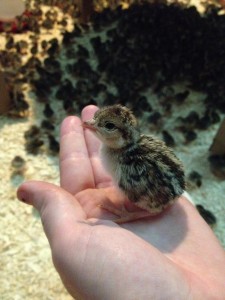
A partridge chick…so tiny!
I live on farm, beginning each day around eight in the morning and working until six. Rick and Linda’s daughters occasionally help out, and there is a farmhand Ramone. We butcher three days a week, and I spend all day Sunday at one of our markets. So far during my four weeks here, I’ve helped with shearing, given vaccinations, installed new fencing, given a dog a haircut, coaxed layers out onto pasture, held impossibly tiny quail chicks, and untangled a kid from Electronet. I’m now quite proficient at bottle-feeding lambs, collecting eggs, gutting chickens, and filling customer orders…not bad for someone who’s spent her whole life in the suburbs! I’m learning a ton, and most of it is random tidbits and insights you’d never find in a textbook. The kind of learning that only comes from hands-on experience, which is of course the very point of the internship requirement. My only given task for the summer is to build the business a website, a process I’m very much enjoying despite its surprising difficulty.
I am surrounded by Cornell alumni. Rick is a Class of ’82 animal science alum, and Q-R-US does a lot of partnering with Twin Brook Farms down the road, managed by Class of 2010 ag sci alum Cassie and her husband Erik, Class of 2010 natural resources. When I wear my Cornell shirts to markets, many customers comment on how beautiful Ithaca is, or how great their education at Cornell was. It makes me so thankful for my Cornell community. I can’t wait to continue to learn from my mentors!
Week 2: Surveys and Scouting
This was another great week at the LIHREC. I began working on the project looking to determine the barriers to broccoli production on long island by surveying a few growers on their current production practices and their growing preferences. Growers were eager to answer my questions and very interested in the Eastern Broccoli Project. I was even rewarded with a few quarts of strawberries at one farm! In addition to surveying, I worked on-site at the research station assisting with research trials. Finally, I participated in crop scouting of a large variety of crops. Looking forward to what next week holds for me.
From Cornell to Channel: My Summer with Monsanto
 My name is Hannah Riensche and I am a rising junior concentrating in business. For a quick background on myself, I am from a conventional corn and soybean farm in northeast Iowa that my family has owned and operated for the last six generations. I am primarily interested in crop sciences and agronomy.
My name is Hannah Riensche and I am a rising junior concentrating in business. For a quick background on myself, I am from a conventional corn and soybean farm in northeast Iowa that my family has owned and operated for the last six generations. I am primarily interested in crop sciences and agronomy.
This summer, I am interning for Channel Bio, LLC (or just Channel for short). The Channel seed company has had an interesting past, originating in 1999 and then was subsequently sold to Monsanto in 2004. In 2009, Monsanto took three more acquired seed companies (Crow’s, Midwest Seed Genetics, and NC+) and combined them together under the Channel name. Today, Channel is one of three seed “divisions” under Monsanto, the others being National brands (Dekalb, Deltapine, & Asgrow) and regional brands like Krueger, Hubner, Lewis, etc.) For those unfamiliar with what seed companies are, Channel sells bulk corn, soybean, alfalfa, and sorghum seed for farmers across the East, Midwest, and Great Plains.
For my internship, I am living next to the PA/OH border on the Ohio side, and go back and forth every day meeting with farmers in eastern Ohio, western New York, and mostly western Pennsylvania. For me, the most rewarding aspect of this internship is having the ability to meet with farmers and hear from a first-person perspective their thoughts, goals, and concerns within their agricultural location. Under a salesman who “owns” these accounts, I go visit these farms with the pretense of learning rather than sales as an intern, which opens up the growers to discuss how they perceive the products offered by the Channel brand. Often, I will go walk fields with growers to observe the crop performance and even make agronomic recommendations.
However, this is not the only thing I do within the internship. Monsanto has a very structured program for their students, requiring that the participating individuals perform three projects over the course of the summer. The first is that students must meet and build a relationship with approx. forty different growers. Second, we must do a project constructed especially for our area by our District Sales Managers and Area Business Managers. My project is doing field scouting and reports for the top ten growers in the district. Lastly, we must complete a corporate project that is assigned to us upon arrival at our training week in St. Louis. My corporate project is contacting the seed dealer network to survey and record grain handling facilities to eventually collaborate with a new product, then compile and map the data. This will be presented at our wrap-up week in St. Louis at the end of the internship.
So far, the experience I have had with Monsanto and Channel has been unmatched to anything I have done before. Not only is the sales team I work under full of dedicated and incredible people, but the knowledge of the business I have gained and the networking I have been able to do with my passionate inter-peer class have really made this a top-notch opportunity. While moving to a new place under a new company may have been difficult at first, it has paid off in more ways imaginable.

This is me scouting soybeans in the early growing season. Cool weather and lots of rain left plenty of room for concerns.
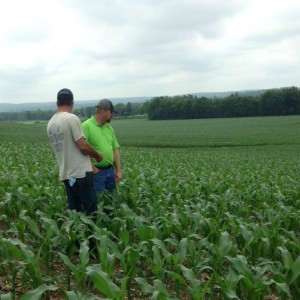
My DSM, Steve (green shirt), out with a grower looking at a test plot comparing varieties of seed side-by-side.
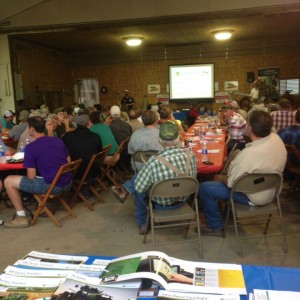
Growers from all over West PA get together for dinner and a guest speaker on grain marketing advice.
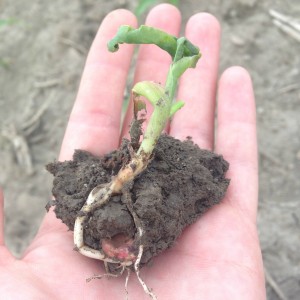
This is corn affected by cold weather. Lots of farmers saw this in fields planted in early May, as temperatures dropped to 28°.
Week 1: Corn, Potatoes, and Beetles…Oh My!
This week marked the first of ten of my summer internship at the Long Island Horticultural Research and Extension Center in Suffolk County. This was an exciting week where I became oriented with the research station and what my summer duties would entail. After a brief introductory session on my first day, I jumped right into work on the research plots digging up potatoes, laying irrigation, placing seeds, and counting hundreds of beetles! I also gained experience in pest scouting for strawberry and sweet corn crops on local farms. Next week I look forward to beginning work on an additional project that works to identify grower perception and availability in regards to expanding their cultivation systems to include broccoli. I had an informative and enjoyable first week and am eager to see what the rest of the summer has in store for me.





